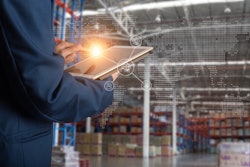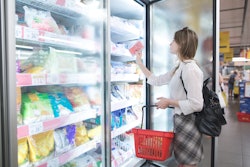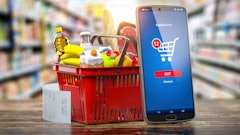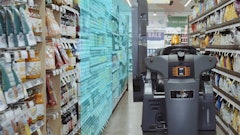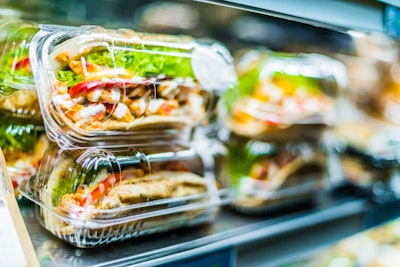
Self-distribution, or the use of in-house resources to manage parts of the supply chain that would traditionally be outsourced, is not new, but it’s definitely on the rise, especially in the food and beverage industry.
The burden of hiring many drivers, merchandisers and other workers shifted to the retailer side, but in reality, many big retailers have been rethinking their physical footprints and converting them into self-distribution centers. Why?
Two main reasons: a focus on costs and an interest in keeping products as close to customers as possible. While this idea may sound quite logical and self-explanatory, there’s more to it than meets the eye.
Evolution of the self-distribution model
The fundamental shift in how retailers view their physical footprint is a consequence of evolving customer expectations. In short, customers want what they want, when they want it and only a flexible supply chain can provide that kind of responsiveness. The future is here; it’s just not evenly distributed yet.
Make no mistake, technology has put real power in buyers’ hands, and they aren’t afraid to use it—even if it means finding another retailer that can better meet their needs.
With many consumer goods adopting direct sales channels faster than ever before, now is an exciting time for those working on building out efficient supply chains. But there are some challenges ahead as well.
While technology makes it easier to keep track of inventory across multiple locations, differentiating between actual sales and channel leakage remains a big challenge for most retailers. And while many brands and retailers continue to push further into e-commerce, others still struggle with getting products from factories to stores efficiently. Regardless of where you sit on that spectrum, one thing is clear: To survive in today’s competitive retail environment, you need a scalable supply chain strategy that allows you to be nimble enough to react quickly but also maintain control over costs and margins.
Why self-distribution?
The sheer size and geographic dispersion of retailers’ physical footprints have made it increasingly difficult to manage them effectively. In a sector where e-commerce is growing rapidly and technology is transforming processes, logistics in particular are under immense pressure. E-commerce sales continue to grow at double digits in most countries, creating substantial pressure on third-party logistics providers (3PLs) and retailers alike.
Big retailers want to be able to control delivery scheduling more closely, reduce costs by cutting out middlemen (such as 3PLs) and focus on customer satisfaction by reducing delivery times; these were among the reasons cited for increased investment in fulfillment centers. However, many big retailers have been rethinking their physical footprints and converting them into self-distribution centers. Self-distribution is on the rise.
Retailers that build or expand distribution centers do so for various reasons. They may need additional capacity because they have grown quickly, particularly through e-commerce channels, but also because they are facing more competition from other retailers building their own facilities. Some companies opt to build such facilities themselves, rather than rely on third parties because they feel that managing such facilities directly allows them greater flexibility in terms of cost management and service levels.
Challenges with self-distribution
Despite all of these benefits, self-distribution comes with its own set of challenges that companies have to face. Self-distribution poses a significant operational risk as it requires a large number of drivers, merchandisers and other workers to deliver products from their central location to retailers across different regions.
Additionally, investing big money to build large-scale distribution centers also requires investment from both ends. This leads many small businesses, which lack capital and resources, to avoid adopting such models for their distribution.
Despite all these challenges, self-distribution has seen a rise in popularity in recent years. A lot of people are beginning to realize that there are more advantages than disadvantages associated with self-distribution and are now willing to take up the challenge and choose to go down this path instead of relying on third-party service providers like wholesalers or 3PLs.
The importance of B2B e-commerce in a self-distribution model
Food and beverage retailers with a large number of chain stores typically use a centralized purchasing structure. Under this structure, there are multiple buyers spread across different departments who purchase products for all locations and send orders to suppliers either via EDI or more recently with B2B e-commerce.
When a big retailer switches to a self-distribution model, it becomes de-facto a distributor to its chain stores like any traditional wholesaler. To make the centralized purchasing process more efficient and transparent, it’s important these self-distribution retailers utilize B2B e-commerce.
With a B2B e-commerce platform, buyers from different departments have access to product information such as images, smart filters, descriptions, pricing and promotions.
At all levels of business, B2B e-commerce brings increased efficiency and durability. Businesses can make better decisions about which products work best for them and have a better awareness of what their customers are doing at all times with big data at their fingertips, making them more successful and less susceptible. Repetitive processes that were formerly completed manually can now be automated, allowing them to be completed at higher rates and with fewer errors.
Implications of the self-distribution model for wholesalers
Traditional food and beverage distributors are under threat, not only from logistics companies wanting a share of this profitable market, but also from new entrants such as big retailers with a self-distribution model.
In order to remain competitive, many wholesalers will need to “go small," shifting their strategy to focus more on smaller- and medium-sized players. The traditional food and beverage distributors and wholesalers that pivot to the changing situation will thrive; however, the rest will experience further erosion in profit margins.
No doubt, landing more small retailers at the expense of large ones and managing them will result in an extra overhead for traditional wholesalers. This is a daunting, extremely expensive and very time-consuming feat – one that is best accomplished through cooperation with a well-chosen B2B e-commerce partner. So, how does a food and beverage wholesaler determine who would be an ideal partner?
The right partner can ensure that the wholesaler establishes, maintains and continuously extends its advantage in this rapidly evolving and highly competitive space.
Make sure your food and beverage B2B e-commerce partner is compatible with your current business applications and technology infrastructure, flexible enough to continuously adapt to changing needs, offers a branded app to boost brand identity and has all the tools in place to track performance.




